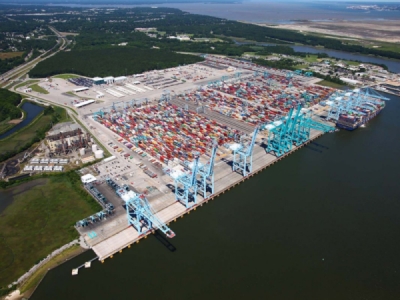
Posted on August 2, 2020
As the third largest container port on the East Coast, the Port of Virginia is used to operating non-stop around the clock to make sure shelves across the region remain fully stocked. With the current state of battery technology, however, the new electric tractors on order to lug goods around the shipyard will likely only be able to manage eight hour shifts before they need to be recharged.
But if the planned pilot project at the Richmond Marine Terminal proves a success, then all 160 yard tractors operating at their six port facilities could soon go electric.
“Cargo handling equipment is one of the best places for us to cut emissions,” said Scott Whitehurst, the port’s director of environmental policy and compliance. “We have to start small so the technology can prove itself. We also have to ensure the equipment we’re buying is durable. We really put our equipment through its paces so we have to make sure it can last.”
Green business is good business
The yard tractor electrification pilot represents just one component of a years-long modernization strategy at the port that has seen millions of dollars invested into optimizing their facilities’ operations specifically to draw environmental benefits. The effort to reduce greenhouse gas emissions and criteria pollutants like carbon dioxide and particulate matter isn’t just the right thing to do, said Joe Harris, port spokesman, it’s good for the future of the business.
“We don’t want to be caught flat-footed by any type of future government mandate,” said Harris. “We want to make sure that we’re investing wisely today so that we don’t find ourselves in the situation of having to throw money at the problem tomorrow.”
To turbo-charge the electrification efforts underway at the Port of Virginia, last month Gov. Ralph Northam announced $14 million in Volkswagen settlement money in assistance. After an investigation by the California Air Resources Board in 2014 revealed that VW had installed “defeat devices” in their diesel vehicles to evade emissions testing, the company ponied up billions of dollars in the resulting legal settlement to resolve the “Dieselgate” scandal. Virginia’s $93.6 million share of the funds was placed in the state’s Volkswagen Environmental Mitigation Trust.
The dollars the governor has dedicated to the port includes $4 million for the yard tractor pilot program as well as $10 million to replace the diesel ship-to-shore cranes at the Norfolk International Terminals with all new electric ones. The move allows the port to avoid consuming 700,000 gallons of diesel fuel over the remaining life of the cranes and go to zero emissions on site, thereby eliminating 1,700 tons of CO2, 46 tons of nitrous oxide, and 2.2 tons of particulate matter.
The infusion of grant money from the state feels transformational to Harris. “These electrification projects had been researched and vetted but they were not going to happen had it not been for the VW funding, at least not this year. We had no clue how to finance this, so this money represents a real opportunity to finally make this move.”
Electrify everything
On the same day the governor announced $14 million for the port, he also dedicated a further $20 million to a brand new Clean Air Communities Program. Specifically, low-income and designated environmental justice communities outlined in this year’s Environmental Justice Act will be eligible for grants from the state to fund projects that reduce air pollution and carbon emissions.
The first grants to be awarded from the trust came out under former Gov. Terry McAuliffe and focused on building out an electric vehicle charging network and the electrification of public transit buses. With roughly $87 million now obligated, these latest allotments from the VW settlement fund likely represent the final grand announcements on how the money will be invested in Virginia’s energy future. Currently, just $6.92 million remain unallocated.
Source: virginiamercury





